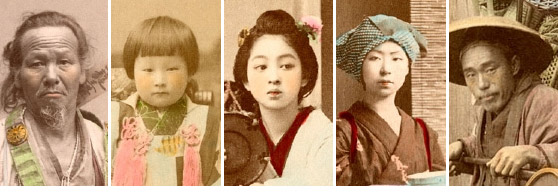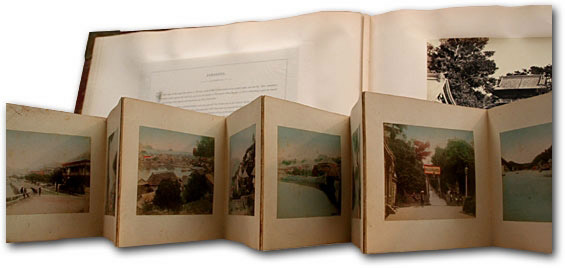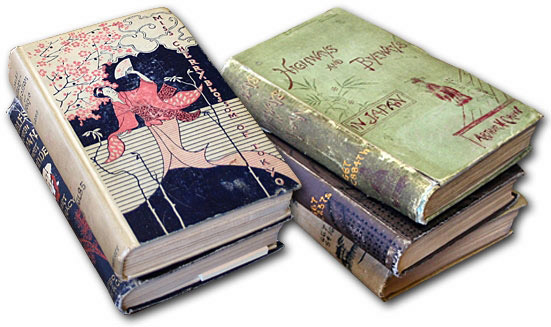| |
Picturing “the Japanese”
Exotic architecture, quaint villages, historic sites, and scenic natural wonders comprised the “must see” list for late-19th-century globetrotters visiting Japan. No trip would be complete, however, without face-to-face encounters with Japanese people. How Japanese lived, the occupations they engaged in, their pleasures, pastimes, manners, customs, dress, and coiffure were equally attractive to curious globetrotters—but the hurried pace of globetrotter travel precluded any development of deep or extended personal relationships. Despite the effort of guidebook authors to facilitate communication by providing rudimentary vocabularies, globetrotter engagement with native Japanese was primarily a visual experience.
Face-to-face encounters across race and culture can be status neutral in the moment they occur—both parties have equal opportunity to observe the otherness of their counterpart. But globetrotter photography tipped this balance in favor of Westerners by convincingly replicating face-to-face experiences with intimate portraits and authentic-looking scenes of daily life. These images afforded travelers the opportunity to scrutinize Japanese people at length and at leisure. They also silenced those who were photographed, stripping them of the ability to look back, to speak in their own defense, and to correct any misunderstandings a foreigner might acquire from a momentary encounter. The seamless transition from a face-to-face to a face-to-photograph experience empowered globetrotters with an opportunity to re-inscribe these images with meanings, associations, and sensibilities that often were far removed from the lived experience of actual Japanese.
|
 |
A sampling of photos of Japanese people published in Brinkley’s Japan, 1897–98.
|
The commercial underpinnings of globetrotter photography in Japan significantly enhanced this power differential. As with any commodity enterprise, market demand determined the viability of specific products. Photographers made the technical and aesthetic decisions necessary to produce engaging images but the predilections of their globetrotter clientele circumscribed the range of marketable subjects. Just as globetrotters exhibited preferences for specific views of the places they visited, so too did they gravitate towards images of Japanese people that best represented their experiences and, more often than not, their expectations.
To understand globetrotter photographs of Japanese people, then, we need to examine both sides of this symbiotic relationship. Of globetrotters we need to ask what aspects of Japanese life and customs they found most attractive and why they were predisposed to these subjects. For photographers, we need to examine how their studio practices, tailored to meet the demands of a foreign market, skewed their clientele’s understanding of Japanese people. Both lines of inquiry speak to a broader and perhaps more important issue. Commercial enterprises that exploit cross-cultural encounters for material gain—such as globetrotter photography—open up the possibility of misrepresentation and stereotyping. We must ask, then, if the globetrotter photographs represent an accurate record of Japanese life, manners, and customs in the late-19th century.
A small number of globetrotter travel narratives recount experiences in treaty-port photography shops, but none of the authors reflect on their inner deliberations when purchasing photographs and compiling albums. Other available resources capable of shedding light on the sensibilities and expectations of globetrotters toward photographic images require assessments of their value as historical evidence. Hundreds of late-19th-century photo albums have survived and, taken all together, reveal general preferences for certain subjects; but it also becomes apparent that each album is unique to the globetrotter who selected the images. |
 |
  The “accordion”-style album was a typical small, portable album globetrotters might acquire; in the background, a Felice Beato album from 10 years earlier. The “accordion”-style album was a typical small, portable album globetrotters might acquire; in the background, a Felice Beato album from 10 years earlier. |
Published travel accounts, most of which were illustrated with photographs or engravings based on them, provide more insightful sources, in that descriptive text often elucidates the author’s attitudes toward the subjects of the illustrations. Like photo albums, however, travel accounts are highly personalized documents. They offer informative but individualized perspectives, and any attempt to generalize from them runs the risk of inaccuracy. In short, globetrotters represent a diverse group, and it is misleading to assume the existence of shared values, attitudes, and expectations from highly personal sources such as photo albums and travel narratives.
|
 |
  A sampling of travel books about Japan written by globetrotting tourists in the late-19th century. A sampling of travel books about Japan written by globetrotting tourists in the late-19th century. |
Captain Frank Brinkley’s Japan: Described and Illustrated by the Japanese (the source of most of the illustrations in this Visualizing Cultures unit) provides a more reliable estimation of globetrotter preferences. Each set of Japan: Described and Illustrated consists of 10 folio-sized volumes of essays on a variety of topics written by eminent Japanese authorities and edited by Brinkley. 16 different editions were published between 1897 and 1898, many with evocative names such as the Mikado Edition, Edition de Grand Luxe, and the Lotus Edition.
|
|
  Brinkley’s 10-volume set, Japan—the deluxe edition from which the illustrations in this unit have been taken. Brinkley’s 10-volume set, Japan—the deluxe edition from which the illustrations in this unit have been taken. |
More exclusive editions were limited to as few as 25 sets and were available only by subscription. Larger editions numbered 750 to 1000 sets. 11 editions were illustrated with 230–260 hand-colored albumen photographs pasted in as illustrations; five lower priced editions used halftone reproductions. Estimations based on surviving bibliographic data suggest that the project required a minimum of 344,500 original photographs. K. Tamamura, a prominent Yokohama photographer, was commissioned to supply the images but was overwhelmed by the size of the order and enlisted the support of other photographers, including his main competitor, Kusakabe Kimbei.
|
  Capt. Brinkley & the Selling of Meiji Japan Capt. Brinkley & the Selling of Meiji Japan
Captain Frank Brinkley’s Japan: Described and Illustrated by the Japanese is the source of the photographs in this unit. 16 different editions of this 10-volume opus were published between 1897 and 1898, including several particularly sumptuous numbered sets. 11 of these editions included pasted-in hand-colored albumen photographs. It is estimated that the whole project required a minimum of 344,500 original photos—a staggering number that eventually required the services of a number of Yokohama studios. |
|
 |
  Brinkley’s long career in Japan coincided almost exactly with the Meiji era itself (1868–1912). He arrived as a young British naval officer in 1867, resigned his commission not many years afterwards, and passed away in 1912, the same year as the Meiji emperor. Brinkley married the daughter of a former samurai, learned to read and write—as well as speak—Japanese, and in a short time emerged as a major publicist and propagandist for the Meiji regime. After early services as a teacher of artillery to the new imperial navy and lecturer in mathematics at what would later become Tokyo Imperial University, he became owner and editor of the Japan Mail newspaper, a position he held from 1881 until his death. This ambitious 10-volume set is an excellent sample of the carefully constructed and highly selective picture of Japan that commercial photographers presented for foreign consumption. This costly project was undertaken in the immediate aftermath of Japan’s stunning victory in the Sino-Japanese War of 1894–95. It received generous financial support from the Japanese government, and its many chapters were all “Written by Eminent Japanese Authorities and Scholars” (as the title page proclaimed). As with many other foreign friends of the modern Japanese state, Brinkley’s services were acknowledged by the award of the third Order of the Sacred Treasure by the Meiji emperor. Brinkley’s long career in Japan coincided almost exactly with the Meiji era itself (1868–1912). He arrived as a young British naval officer in 1867, resigned his commission not many years afterwards, and passed away in 1912, the same year as the Meiji emperor. Brinkley married the daughter of a former samurai, learned to read and write—as well as speak—Japanese, and in a short time emerged as a major publicist and propagandist for the Meiji regime. After early services as a teacher of artillery to the new imperial navy and lecturer in mathematics at what would later become Tokyo Imperial University, he became owner and editor of the Japan Mail newspaper, a position he held from 1881 until his death. This ambitious 10-volume set is an excellent sample of the carefully constructed and highly selective picture of Japan that commercial photographers presented for foreign consumption. This costly project was undertaken in the immediate aftermath of Japan’s stunning victory in the Sino-Japanese War of 1894–95. It received generous financial support from the Japanese government, and its many chapters were all “Written by Eminent Japanese Authorities and Scholars” (as the title page proclaimed). As with many other foreign friends of the modern Japanese state, Brinkley’s services were acknowledged by the award of the third Order of the Sacred Treasure by the Meiji emperor.
|
The value of Brinkley’s Japan as a historical resource lies in its extensive use of original photographs. Globetrotters constituted the primary clientele for Tamamura, Kimbei, and other commercial photographers who committed photographs to the Brinkley project. Most of the images came straight from the inventories globetrotters would have confronted when purchasing photographs to commemorate their travels. The scale of the Brinkley project further enhances its value, for its encyclopedic coverage of Japanese life and customs surpasses that of any single globetrotter album and provides an indication of the thematic range of images globetrotters encountered in commercial studios.
Even this elaborate and voluminous source, however, is not without problems. Although Brinkley is the person most often associated with this publication, the Boston publisher J.B. Millet conceptualized the project and brought it to fruition. Recognizing the inherent financial risk in an undertaking of this scale, Millet solicited and received generous support from the Japanese government, which at the time (immediately following its victory in the Sino-Japanese War) had a vested interest in promoting a specific image of Japan to the international community. Brinkley’s Japan is compromised by this official involvement. Although the photographs it contains cover a broad range of places, people, and activities, problematical themes were judiciously avoided. All parties involved in the project—Brinkley, Millet, and the Japanese government—strove to present what was in their minds an attractive and uncontroversial image of Japan.
The analysis that follows utilizes the sources introduced here. Brinkley’s Japan offers a range of photographic imagery, roughly consistent with that sought by globetrotters. Albums and travel narratives provide individualized examples and anecdotal evidence that help explain globetrotter interest in specific subjects and themes. Additionally, reference is made to a rare but representative 1893 price list of over 2,000 souvenir photographs published by Kimbei, who was one of Yokohama’s leading commercial photographers. Collectively these sources offer insights into globetrotter attitudes towards the Japanese people they encountered (or imagined encountering) during their travels and memorialized with photographs they added to their albums.
|

Brinkley’s Japan courtesy of Hood Museum of Art, Dartmouth College
On viewing images of a potentially disturbing nature: click here.
|
|
|
|
|

